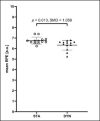Effects of Four Weeks of Static vs. Dynamic Bodyweight Exercises with Whole-Body Electromyostimulation on Jump and Strength Performance: A Two-Armed, Randomized, Controlled Trial
- PMID: 37293409
- PMCID: PMC10244999
- DOI: 10.52082/jssm.2023.226
Effects of Four Weeks of Static vs. Dynamic Bodyweight Exercises with Whole-Body Electromyostimulation on Jump and Strength Performance: A Two-Armed, Randomized, Controlled Trial
Abstract
The combination of strength training with complementary whole-body electromyostimulation (WB-EMS) and plyometric exercises has been shown to increase strength and jumping performance in athletes. In elite sport, however, the mesocycles of training are often organized according to block periodization. Furthermore, WB-EMS is often applied onto static strength exercises, which may hamper the transfer into more sport-specific tasks. Thus, this study aimed at investigating whether four weeks of strength training with complementary dynamic vs. static WB-EMS followed by a four-week block of plyometric training increases maximal strength and jumping performance. A total of n = 26 (13 female/13 male) trained adults (20.8 ± 2.2 years, 69.5 ± 9.5kg, 9.7 ± 6.1h of training/w) were randomly assigned to a static (STA) or volume-, load- and work-to-rest-ratio-matched dynamic training group (DYN). Before (PRE), after four weeks (three times weekly) of WB-EMS training (MID) and a subsequent four-week block (twice weekly) of plyometric training (POST), maximal voluntary contraction (MVC) at leg extension (LE), leg curl (LC) and leg press machines (LP) and jumping performance (SJ, Squat Jump; CMJ, counter-movement-jump; DJ, drop-jump) were assessed. Furthermore, perceived effort (RPE) was rated for each set and subsequently averaged for each session. MVC at LP notably increased between PRE and POST in both STA (2335 ± 539 vs. 2653 ± 659N, standardized mean difference [SMD] = 0.528) and DYN (2483 ± 714N vs. 2885 ± 843N, SMD = 0.515). Reactive strength index of DJ showed significant differences between STA and DYN at MID (162.2 ± 26.4 vs. 123.1 ± 26.5 cm·s-1, p = 0.002, SMD = 1.478) and POST (166.1 ± 28.0 vs. 136.2 ± 31.7 cm·s-1, p = 0.02, SMD = 0.997). Furthermore, there was a significant effect for RPE, with STA rating perceived effort higher than DYN (6.76 ± 0.32 vs. 6.33 ± 0.47 a.u., p = 0.013, SMD = 1.058). When employing a training block of high-density WB-EMS both static and dynamic exercises lead to similar adaptations.
Keywords: MVC; Periodization; WB-EMS; fatigue; jump; plyometrics.
© Journal of Sports Science and Medicine.
Figures



Similar articles
-
Effects of an Eight-Week Superimposed Submaximal Dynamic Whole-Body Electromyostimulation Training on Strength and Power Parameters of the Leg Muscles: A Randomized Controlled Intervention Study.Front Physiol. 2018 Dec 5;9:1719. doi: 10.3389/fphys.2018.01719. eCollection 2018. Front Physiol. 2018. PMID: 30568596 Free PMC article.
-
Effects of Whole-Body Electromyostimulation on Strength-, Sprint-, and Jump Performance in Moderately Trained Young Adults: A Mini-Meta-Analysis of Five Homogenous RCTs of Our Work Group.Front Physiol. 2019 Nov 8;10:1336. doi: 10.3389/fphys.2019.01336. eCollection 2019. Front Physiol. 2019. PMID: 31780950 Free PMC article.
-
The Effects of Superimposed Whole-Body Electromyostimulation During Short-Term Strength Training on Physical Fitness in Physically Active Females: A Randomized Controlled Trial.Front Physiol. 2019 Jun 27;10:728. doi: 10.3389/fphys.2019.00728. eCollection 2019. Front Physiol. 2019. PMID: 31316389 Free PMC article.
-
Electromyostimulation--a systematic review of the effects of different electromyostimulation methods on selected strength parameters in trained and elite athletes.J Strength Cond Res. 2012 Sep;26(9):2600-14. doi: 10.1519/JSC.0b013e31823f2cd1. J Strength Cond Res. 2012. PMID: 22067247 Review.
-
Electromyostimulation--a systematic review of the influence of training regimens and stimulation parameters on effectiveness in electromyostimulation training of selected strength parameters.J Strength Cond Res. 2011 Nov;25(11):3218-38. doi: 10.1519/JSC.0b013e318212e3ce. J Strength Cond Res. 2011. PMID: 21993042 Review.
References
-
- Borg G., Ljunggren G., Ceci R. (1985) The increase of perceived exertion, aches and pain in the legs, heart rate and blood lactate during exercise on a bicycle ergometer. European Journal of Applied Physiology and Occupational Physiology 54, 343-349. https://doi.org/10.1007/BF02337176 10.1007/BF02337176 - DOI - PubMed
-
- Cohen J. (1988) Statistical Power Analysis for the Behavioral Sciences. Hillside: : Lawrence Earlbaum Associates.
-
- Dörmann U. (2011) Isometrische und isoinertiale Parameter in der Kraftdiagnostik: Reliabilitätsprüfung und Evaluation von Effekten mechanischer und elektrischer Krafttrainingsreize. Deutsche Sporthochschule Köln, Cologne.
-
- Dörmann U., Wirtz N., Micke F., Morat M., Kleinöder H., Donath L. (2019) The Effects of Superimposed Whole-Body Electromyostimulation During Short-Term Strength Training on Physical Fitness in Physically Active Females: A Randomized Controlled Trial. Frontiers in Physiology 10, 728. https://doi.org/10.3389/fphys.2019.00728 10.3389/fphys.2019.00728 - DOI - PMC - PubMed
-
- Filipovic A., Grau M., Kleinöder H., Zimmer P., Hollmann W., Bloch W. (2016) Effects of a Whole-Body Electrostimulation Program on Strength, Sprinting, Jumping, and Kicking Capacity in Elite Soccer Players. Journal of sports science & medicine 15, 639-648. https://pubmed.ncbi.nlm.nih.gov/27928210/ - PMC - PubMed
Publication types
MeSH terms
LinkOut - more resources
Full Text Sources
